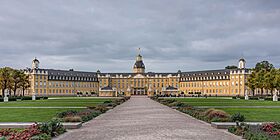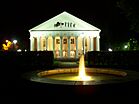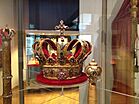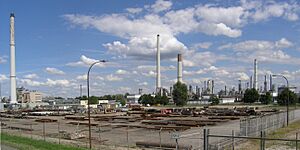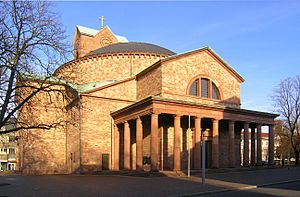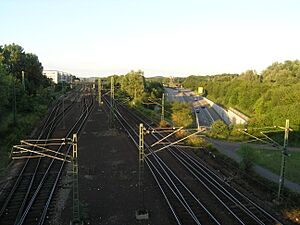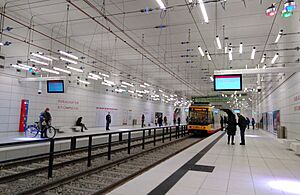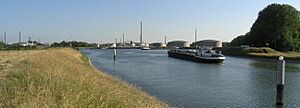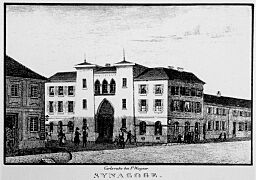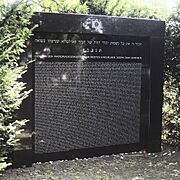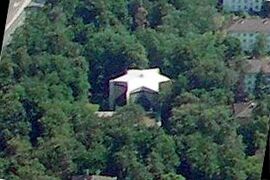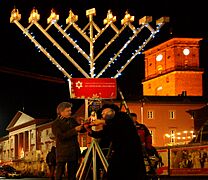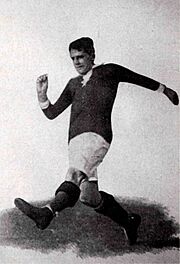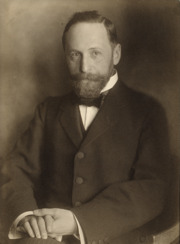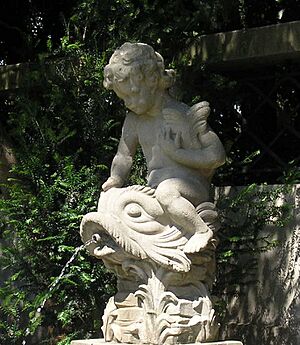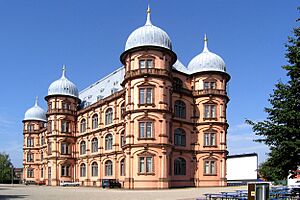Karlsruhe facts for kids
Quick facts for kids
Karlsruhe
Kallsruh (South Franconian)
|
|||
|---|---|---|---|
|
Clockwise from top: Karlsruhe Palace, Schlossplatz, Crown of Baden, Konzerthaus, view over Karlsruhe
|
|||
|
|||
| Country | Germany | ||
| State | Baden-Württemberg | ||
| Admin. region | Karlsruhe | ||
| District | Urban district | ||
| Founded | 1715 | ||
| Elevation | 115 m (377 ft) | ||
| Population
(2022-12-31)
|
|||
| • Total | 308,707 | ||
| Time zone | CET/CEST (UTC+1/+2) | ||
| Postal codes |
76131–76229
|
||
| Dialling codes | 0721 | ||
| Vehicle registration | KA | ||
| Website | karlsruhe.de | ||
Karlsruhe is a big city in the German state of Baden-Württemberg. It is the third-largest city in this state. Only Stuttgart and Mannheim are bigger. Karlsruhe is also the 22nd-largest city in all of Germany. About 308,000 people live there.
The city is located near the Rhine river, close to the French border. It is known as Germany's legal center. This is because important courts like the Federal Constitutional Court are in Karlsruhe.
Karlsruhe used to be the capital of a historic region called Baden. The city was founded in 1715. Its most famous building is Karlsruhe Palace, built in the same year. This palace now holds the Baden State Museum. This museum shows the culture, art, and history of the Baden region.
The city is also a hub for learning. It has nine universities and colleges. The most famous one is the Karlsruhe Institute of Technology. Karlsruhe/Baden-Baden Airport is the second busiest airport in Baden-Württemberg.
Contents
- Exploring Karlsruhe's Location
- City Districts
- Karlsruhe's History
- Population Growth
- Top Sights in Karlsruhe
- Karlsruhe's Economy
- Getting Around Karlsruhe
- Jewish Community in Karlsruhe
- Famous People from Karlsruhe
- Education in Karlsruhe
- Culture and Arts
- Sister Cities
- Karlsruhe's Legacy
- Events in Karlsruhe
- Sports in Karlsruhe
- Images for kids
- See also
Exploring Karlsruhe's Location

Karlsruhe is located on the east side of the Rhine river. It sits mostly on the Upper Rhine Plain. The city also touches the Kraichgau hills and the edge of the Northern Black Forest.
The Rhine river is a very important shipping route. It forms the western border of the city. The city center is about 7.5 kilometers (4.7 miles) from the river. Two smaller rivers, the Alb and the Pfinz, flow through Karlsruhe. They both eventually join the Rhine.
The city's elevation ranges from 100 to 322 meters (328 to 1,056 feet). The highest point is near a communications tower. The 49th parallel north line runs right through the city center. This means Karlsruhe is at the same latitude as cities like Paris and Vancouver. A special stone and painted line in the Stadtgarten (city park) mark this parallel.
Karlsruhe covers an area of 173.46 square kilometers (67 square miles). This makes it the 30th largest city in Germany by land area. The city is about 16.8 kilometers (10.4 miles) long from north to south. It is 19.3 kilometers (12 miles) wide from east to west.
Karlsruhe is part of a larger urban area that includes nearby towns. These towns are in the Karlsruhe district. Examples are Bruchsal, Ettlingen, and Rheinstetten. The city of Pforzheim is also part of this area.
The city was designed with the palace tower at its center. 32 streets spread out from the palace like the spokes of a wheel. This is why Karlsruhe is often called the "fan city" (Fächerstadt). Most of these streets are still there today. This unique layout even led to a special way of measuring distance in math, called the Karlsruhe metric.
The city center is the oldest part of Karlsruhe. It is south of the palace. The palace itself runs east to west. It has two wings that point southeast and southwest. These wings line up with the streets that form the city center's boundaries.
The main market square is on the street that goes south from the palace. The market square has the city hall (Rathaus) on one side. The main Lutheran church is on the other side. The tomb of the city's founder, Margrave Charles III William, is inside a pyramid in the square. This makes Karlsruhe one of the few large German cities with buildings in the neoclassical style.
The area north of the palace is a large park and forest. The area to the east used to be gardens and forests. Some of these remain. But now, the Karlsruhe Institute of Technology, the Wildparkstadion football stadium, and homes are also there. The area west of the palace is mostly residential now.
Karlsruhe's Climate
Karlsruhe has an oceanic climate. This means its winters are milder than in most other German cities. Summers are warm, with temperatures sometimes reaching between 35 and 40 degrees Celsius (95 and 104 degrees Fahrenheit).
The city is also one of the sunniest in Germany. It gets over 2,000 hours of sunshine each year. Most of the rain falls in winter. In summer, rain often comes as short thunderstorms in the evening.
| Climate data for Karlsruhe (1991–2020 normals, extremes 1948–2020) | |||||||||||||
|---|---|---|---|---|---|---|---|---|---|---|---|---|---|
| Month | Jan | Feb | Mar | Apr | May | Jun | Jul | Aug | Sep | Oct | Nov | Dec | Year |
| Record high °C (°F) | 17.5 (63.5) |
22.0 (71.6) |
26.7 (80.1) |
30.4 (86.7) |
33.3 (91.9) |
37.3 (99.1) |
39.2 (102.6) |
40.2 (104.4) |
33.2 (91.8) |
29.5 (85.1) |
22.0 (71.6) |
19.2 (66.6) |
40.2 (104.4) |
| Mean maximum °C (°F) | 13.2 (55.8) |
15.6 (60.1) |
20.3 (68.5) |
25.9 (78.6) |
29.5 (85.1) |
33.3 (91.9) |
35.2 (95.4) |
34.4 (93.9) |
28.7 (83.7) |
23.9 (75.0) |
17.3 (63.1) |
13.5 (56.3) |
36.5 (97.7) |
| Mean daily maximum °C (°F) | 5.3 (41.5) |
7.3 (45.1) |
12.1 (53.8) |
17.1 (62.8) |
21.0 (69.8) |
24.7 (76.5) |
27.0 (80.6) |
26.8 (80.2) |
21.8 (71.2) |
16.0 (60.8) |
9.5 (49.1) |
6.0 (42.8) |
16.2 (61.2) |
| Daily mean °C (°F) | 2.5 (36.5) |
3.5 (38.3) |
7.1 (44.8) |
11.2 (52.2) |
15.3 (59.5) |
18.9 (66.0) |
20.8 (69.4) |
20.4 (68.7) |
15.8 (60.4) |
11.1 (52.0) |
6.3 (43.3) |
3.3 (37.9) |
11.4 (52.4) |
| Mean daily minimum °C (°F) | −0.3 (31.5) |
-0.0 (32.0) |
2.5 (36.5) |
5.3 (41.5) |
9.4 (48.9) |
13.0 (55.4) |
15.0 (59.0) |
14.6 (58.3) |
10.7 (51.3) |
7.1 (44.8) |
3.2 (37.8) |
0.6 (33.1) |
6.8 (44.2) |
| Mean minimum °C (°F) | −8.7 (16.3) |
−7.0 (19.4) |
−3.8 (25.2) |
−1.4 (29.5) |
2.8 (37.0) |
7.5 (45.5) |
10.2 (50.4) |
9.3 (48.7) |
5.0 (41.0) |
0.4 (32.7) |
−3.3 (26.1) |
−7.5 (18.5) |
−11.3 (11.7) |
| Record low °C (°F) | −20.0 (−4.0) |
−15.9 (3.4) |
−14.6 (5.7) |
−5.3 (22.5) |
−0.9 (30.4) |
3.6 (38.5) |
6.9 (44.4) |
6.3 (43.3) |
1.4 (34.5) |
−4.1 (24.6) |
−9.3 (15.3) |
−18.7 (−1.7) |
−20.0 (−4.0) |
| Average precipitation mm (inches) | 57.0 (2.24) |
52.6 (2.07) |
52.4 (2.06) |
45.2 (1.78) |
75.7 (2.98) |
70.2 (2.76) |
77.2 (3.04) |
62.0 (2.44) |
54.8 (2.16) |
66.5 (2.62) |
64.4 (2.54) |
72.0 (2.83) |
750 (29.52) |
| Average snowy days (≥ 1.0 cm) | 5.0 | 3.8 | 1.4 | 0 | 0 | 0 | 0 | 0 | 0 | 0 | 0.5 | 3.1 | 13.8 |
| Average relative humidity (%) | 83.4 | 78.9 | 73.6 | 67.8 | 69.0 | 68.1 | 68.0 | 69.3 | 76.6 | 83.2 | 86.9 | 86.2 | 75.9 |
| Mean monthly sunshine hours | 57.4 | 85.1 | 143.7 | 196.8 | 223.7 | 239.7 | 257.0 | 239.9 | 180.8 | 111.8 | 60.9 | 43.0 | 1,832.2 |
| Source 1: World Meteorological Organization | |||||||||||||
| Source 2: Data derived from Deutscher Wetterdienst | |||||||||||||
City Districts
Karlsruhe is divided into 27 different areas called districts.
Karlsruhe's History
The name Karlsruhe means "Charles' repose" or "Charles' peace." Legend says that Margrave Charles III William founded the city after a dream. In his dream, he saw himself building a new city. Another story says he built the palace to find peace from his wife.
Charles William started the city on June 17, 1715. This happened after a disagreement with the people of his old capital, Durlach. The building of Karlsruhe Palace is closely tied to the city's beginning. Karlsruhe became the capital of Baden-Durlach. Later, it was the capital of the united region of Baden until 1945.
In 1822, the Ständehaus was built. This was the first parliament building in a German state. A republican government was elected there after the democratic revolution of 1848.
Thomas Jefferson, who later became a US president, visited Karlsruhe. He was the American envoy to France at the time. When Pierre Charles L'Enfant was planning Washington, D.C., Jefferson showed him maps of European towns, including a sketch he made of Karlsruhe.
In 1860, the first international meeting of chemists, the Karlsruhe Congress, was held here.
During Kristallnacht in 1938, the Adass Jeshurun synagogue was destroyed by fire. Jewish people in the city faced terrible persecution. Many were forced to leave their homes and were sent to camps. Over 1,400 Jewish people from Karlsruhe lost their lives during this time. The city was also a site for forced labor camps during World War II.
Much of central Karlsruhe, including the palace, was destroyed by bombs during World War II. But the city was rebuilt after the war. Karlsruhe was part of West Germany until 1990. In 1995, American military bases in the city closed. Their facilities were then given to the city of Karlsruhe.
Population Growth
| Historical population | ||
|---|---|---|
| Year | Pop. | ±% |
| 1720 | 2,347 | — |
| 1770 | 3,333 | +42.0% |
| 1800 | 7,275 | +118.3% |
| 1834 | 21,047 | +189.3% |
| 1871 | 36,582 | +73.8% |
| 1890 | 73,684 | +101.4% |
| 1900 | 97,185 | +31.9% |
| 1919 | 135,952 | +39.9% |
| 1925 | 145,694 | +7.2% |
| 1933 | 154,902 | +6.3% |
| 1939 | 190,081 | +22.7% |
| 1950 | 201,013 | +5.8% |
| 1956 | 222,237 | +10.6% |
| 1961 | 244,942 | +10.2% |
| 1971 | 258,409 | +5.5% |
| 1976 | 276,620 | +7.0% |
| 1981 | 271,877 | −1.7% |
| 1986 | 268,309 | −1.3% |
| 1990 | 275,061 | +2.5% |
| 2001 | 279,578 | +1.6% |
| 2011 | 289,173 | +3.4% |
| 2022 | 305,408 | +5.6% |
| Population size may be affected by changes in administrative divisions. | ||
Karlsruhe has a population of about 310,000 people. It is the third-largest city in Baden-Württemberg. The city grew a lot in the 19th century. In the 1950s, Karlsruhe became an even more important city. Its population started to grow quickly.
Many students came to Karlsruhe because of its universities. The city reached 200,000 people in 1950. By 2014, it had grown to 300,000 people.
| Rank | Nationality | Population (31 December 2022) |
|---|---|---|
| 1 | 6,369 | |
| 2 | 5,618 | |
| 3 | 4,568 | |
| 4 | 3,637 | |
| 5 | 3,433 | |
| 6 | 3,089 | |
| 7 | 2,542 | |
| 8 | 2,352 | |
| 9 | 1,746 | |
| 10 | 1,712 | |
| 11 | 1,502 | |
| 12 | 1,384 | |
| 13 | 1,294 | |
| 14 | 1,258 | |
| 15 | 1,183 |
Top Sights in Karlsruhe
The Stadtgarten is a fun park near the main train station. It was rebuilt for a big garden show in 1967. The Karlsruhe Zoo is also located here.
The Durlacher Turmberg has a lookout tower. This tower is a very old keep from the 13th century.
Karlsruhe has two botanical gardens. One is the city's own Botanischer Garten Karlsruhe. It is part of the Palace complex. The other is the Botanischer Garten der Universität Karlsruhe, run by the university.
The Marktplatz (Market Square) has a stone pyramid. This pyramid marks the grave of the city's founder. Built in 1825, it is a symbol of Karlsruhe. The city is called the "fan city" because its streets spread out like a fan from the Palace.
The Karlsruhe Palace (Schloss) is a beautiful building. Its nearby garden, the Schlossgarten, has a botanical garden. This garden features palm, cactus, and orchid houses. There are also walking paths through the woods.
The Kleine Kirche (Little Church) was built between 1773 and 1776. It is the oldest church in Karlsruhe's city center.
The architect Friedrich Weinbrenner designed many of the city's important buildings. Another sight is the Rondellplatz. It has 'Constitution Building Columns' from 1826. These honor Baden's first constitution from 1818. This constitution was very modern for its time. The Münze (mint), built in 1826/27, was also designed by Weinbrenner.
The St. Stephan parish church is a great example of neoclassical church design. Weinbrenner built it between 1808 and 1814. He designed it to look like the Pantheon, Rome.
The neo-Gothic Grand Ducal Burial Chapel was built between 1889 and 1896. It is a mausoleum (a building for tombs), not a church. It is located in the middle of a forest.
Karlsruhe's main cemetery is the oldest park-like cemetery in Germany. Its crematorium was the first built to look like a church.
The city also has a natural history museum. There is an opera house (the Baden State Theatre). Many smaller theaters and art galleries are also found here. The State Art Gallery was built in 1846. It shows paintings and sculptures from six centuries. Karlsruhe's newly updated art museum is one of the most important in Baden-Württemberg.
Other cultural places are in Karlsruhe's different suburbs. The Scheffel Association, started in 1924, is Germany's largest literary society. Today, it is housed in the Prinz-Max-Palais. This building was built in neoclassical style between 1881 and 1884.

Because the population grew in the late 1800s, Karlsruhe developed new neighborhoods. Many buildings from this time are in the beautiful Art Nouveau style.
Karlsruhe is also home to the Majolika-Manufaktur. This is the only art-ceramics pottery studio in Germany. It was founded in 1901 and is in the Schlossgarten. A 'blue streak' of 1,645 ceramic tiles connects the studio to the Palace. It is the world's largest ceramic artwork.
Another popular place is the Centre for Art and Media (ZKM). It is located in a building that used to be an ammunition factory.
Karlsruhe's Economy
Germany's largest oil refinery is in Karlsruhe. It is on the western edge of the city, right by the Rhine river. The Technologieregion Karlsruhe is a group of cities. They work together to support high tech industries. About 20% of the jobs in this region are in research and development. EnBW, one of Germany's biggest electric utility companies, has its main office in Karlsruhe.
Internet Activities
Karlsruhe became known as Germany's "internet capital." This was because the Karlsruhe Institute of Technology provided internet services until the late 1990s.
Two big internet service providers, WEB.DE and schlund+partner/1&1, are located in Karlsruhe. They are both owned by United Internet AG.
The library of the Karlsruhe Institute of Technology created the Karlsruher Virtueller Katalog. This was the first website that let researchers search many library catalogs worldwide for free.
In 2000, the online newspaper ka-news.de was started. It provides daily news and information about events in Karlsruhe.
Besides big companies, Karlsruhe has many new and growing startup businesses. The local high tech industry provides over 22,000 jobs.
Getting Around Karlsruhe
Railway Travel
The Verkehrsbetriebe Karlsruhe (VBK) runs the city's public transport. This includes seven tram routes and many bus routes. You can reach all parts of the city day and night by tram and night bus. The Turmbergbahn funicular railway is also run by the VBK. It is located east of the city center.
The VBK also works with other companies to run the Karlsruhe Stadtbahn. This is a train system that serves the area around the city. It lets you travel to nearby towns like Ettlingen and Pforzheim. You can even reach Freudenstadt in the Black Forest from the city center. The Stadtbahn is famous for being one of the first systems to run trams on regular train tracks. This makes public transport more efficient.
Karlsruhe is well-connected by roads and railways. It has Autobahn and Intercity Express train connections. These go to major cities like Frankfurt, Stuttgart, and Munich. Since 2007, Karlsruhe has been connected to the TGV network. This means you can travel to Paris in just three hours.
The Rhine Valley Railway is an important line for freight trains. Freight trains can go around the main station using the Karlsruhe freight bypass railway.
Shipping by River
Two ports on the Rhine river help transport goods. They are especially used for petroleum products on cargo ships.
Airport Access
The closest airport is part of the Baden Airpark. It is about 45 kilometers (28 miles) southwest of Karlsruhe. This airport has regular flights to cities in Germany and Europe. Frankfurt International Airport is about an hour and a half away by car. Stuttgart Airport is about an hour away by car.
City Streets and Roads
Karlsruhe is located on the Bundesautobahn 5 and the Bundesstraße 10. The city also has a great network of bike lanes.
Two interesting facts about transportation history are linked to Karlsruhe. Karl Drais, who invented the bicycle, was born here. Also, Karl Benz, who invented the automobile, was born in Mühlburg. Mühlburg later became a part of Karlsruhe. Benz also studied at Karlsruhe University. His wife, Bertha, took the world's first long-distance car trip. She drove from Mannheim to Karlsruhe-Grötzingen and Pforzheim.
Jewish Community in Karlsruhe
Jews began to live in Karlsruhe soon after it was founded. They were welcomed with many benefits. Official records show Jewish families in Karlsruhe by 1717. By 1718, they had formed an organized community.
As the city grew, it became harder for Jews to settle there. In 1783, a new rule changed things. Margrave Charles Frederick of Baden declared that Jews were no longer tied to the land. This meant they could live wherever they wanted.
In 1808, a new constitution gave Jews citizenship. An edict in 1809 recognized Jews as a religious group. This led to a structured organization for Jewish communities in Baden. A central council was set up in Karlsruhe. A chief rabbi for Karlsruhe and Baden was also appointed.
Jews gained full equal rights in 1862. They were elected to the city council and parliament. By 1890, some were even appointed as judges.
Today, there are about 900 members in the Jewish community. Many of them are new immigrants from Russia. Karlsruhe has created a memorial park to remember its Jewish community and old synagogues.
-
The Karlsruhe Synagogue, built by Friedrich Weinbrenner in 1798 (existed until 1871)
Remembering the Holocaust in Karlsruhe
On October 28, 1938, Jewish men of Polish origin were forced to leave Karlsruhe. Their families later joined them. Many of them did not survive. During Kristallnacht (November 9–10, 1938), the Adass Jeshurun synagogue was burned down. The main synagogue was also damaged. Jewish men were taken to a concentration camp.
Deportations of Jewish people from Karlsruhe began on October 22, 1940. Many were sent to the Gurs concentration camp in France. Others were sent to different camps between 1942 and 1945. Out of 1,280 Jews sent directly from Karlsruhe, 1,175 died. Another 138 died after being sent from other places. In total, 1,421 Jewish people from Karlsruhe died during the Holocaust.
After the war, a new Jewish community was formed by those who survived. A new synagogue was built in 1971. In 1980, the community had 359 members.
Famous People from Karlsruhe
- Dennis Aogo (born 1987), a football defender.
- Karl Benz (1844–1929), the inventor of the first automobile. He founded Benz & Co., which later became part of Mercedes-Benz. He was born in Mühlburg, a part of Karlsruhe.
- Oliver Bierhoff (born 1968), a retired football striker. He was a captain for the German national team.
- Karl Drais (1785–1851), the inventor of the two-wheeler. This invention was the basis for bicycles and motorcycles. He was born and died in Karlsruhe.
- Erik H. Erikson (1902–1994), a children's psychoanalyst. He was a pioneer in studying how identity is built. He spent his childhood and school years in Karlsruhe.
- Gottfried Fuchs (1889–1972), born in Karlsruhe. He holds a record for scoring ten goals in one international soccer match for Germany.
- Moon Ga-young (born 1996), a South Korean actress and model, born in Karlsruhe.
- Regina Halmich (born 1976), a retired female boxing world champion.
- Heinrich Rudolf Hertz, discovered electromagnetic waves at the University of Karlsruhe in the 1880s.
- Julius Hirsch (1892–1945), an Olympic soccer player. He was the first Jewish member of the German national team.
- Oliver Kahn (born 1969), a retired football goalkeeper. He played for Karlsruher SC and Bayern Munich.
- Pietro Lombardi (born 1992), a singer.
- Mehmet Scholl (born 1970), a retired footballer. He played for Karlsruher SC and the German national team.
- Peter Sloterdijk (born 1947), a German philosopher.
- Johann Gottfried Tulla (1770–1828), helped to make the Rhine river straighter. He also helped found the Karlsruhe University in 1825.
- Victoria of Baden (1862–1930), born in Karlsruhe. She became the queen of Sweden.
- Friedrich Weinbrenner (1766–1826), an architect known for his neoclassical designs.
- Richard Willstätter, won the 1915 Nobel Prize for Chemistry.
Education in Karlsruhe
- Bismarck-Gymnasium Karlsruhe
Karlsruhe is a well-known center for research and study. It has some of Germany's best universities.
Technology, Engineering, and Business Studies
The Karlsruhe University (Universität Karlsruhe-TH) is the oldest technical university in Germany. It is home to the Forschungszentrum Karlsruhe (Karlsruhe Research Center). Here, scientists and engineers do research in health, earth, and environmental sciences.
The Karlsruhe University of Applied Sciences (Hochschule Karlsruhe-HS) is the largest technology university in Baden-Württemberg. It offers training and degrees in engineering and business. In 2009, the University of Karlsruhe joined the Forschungszentrum Karlsruhe. Together, they formed the Karlsruhe Institute of Technology (KIT).
Arts Education
The Academy of Fine Arts, Karlsruhe is one of Germany's smallest universities. It has about 300 students. The Karlsruhe University of Arts and Design (HfG) was founded at the same time as the Centre for Art and Media Karlsruhe (ZKM). The HfG focuses on teaching and research about new media and media art.
The Hochschule für Musik Karlsruhe is a music school. It offers degrees in composition, music performance, teaching, and radio journalism. Since 1989, it has been located in the Gottesaue Palace.
International Learning Opportunities
The Karlshochschule International University was founded in 2004. It is a private business school. Karlshochschule offers college degrees in both German and English. It focuses on international business and cultural studies. It also has a Master of Arts program in leadership studies taught in English.
European Institute of Innovation and Technology (EIT)
Karlsruhe hosts one of the European Institute of Innovation and Technology's (EIT) special centers. This center focuses on sustainable energy. Other similar centers are in cities like Grenoble, France, and Stockholm, Sweden.
University of Education
The Karlsruhe University of Education was founded in 1962. It specializes in teaching and learning processes. The university has about 3,700 students and 180 full-time teachers and researchers. It offers many different education programs. These include teaching for primary and secondary schools. It also has programs in Early Childhood Education and Health and Leisure Education. There are Master's programs in Educational Science and Intercultural Education.
Culture and Arts
In 1999, the ZKM (Centre for Art and Media) opened. The ZKM connects new media ideas with practical art. It is located in a building that used to be a weapons factory. The Staatliche Hochschule für Gestaltung (State University of Design) is linked to the ZKM.
Sister Cities
Karlsruhe is connected with these cities around the world:
 Nancy, France (since 1955)
Nancy, France (since 1955) Nottingham, England, United Kingdom (since 1969)
Nottingham, England, United Kingdom (since 1969) Halle, Germany (since 1987)
Halle, Germany (since 1987) Krasnodar, Russia (since 1997)
Krasnodar, Russia (since 1997) Timișoara, Romania (since 1997)
Timișoara, Romania (since 1997) Vinnytsia, Ukraine (since 2022)
Vinnytsia, Ukraine (since 2022)
Partnerships
Karlsruhe also works closely with:
 Oulu, Finland
Oulu, Finland
Karlsruhe's Legacy
- The Ukrainian village Stepove was founded by German settlers and named Karlsruhe.
- The element Protactinium was discovered here in 1913.
Events in Karlsruhe
Every July, there is a big outdoor festival called Das Fest ("The Festival"). It lasts for three days.
The Baden State Theatre has hosted the Händel Festival since 1978.
Karlsruhe hosted the 23rd and 31st European Juggling Conventions (EJC) in 2000 and 2008.
In July, the African Summer Festival takes place in the city's Nordstadt area. This festival includes markets, drumming workshops, and music. It also has many activities for children.
In the past, Karlsruhe hosted LinuxTag, Europe's biggest Linux event. Until 2006, it also hosted the annual Linux Audio Conference.
Visitors and locals watched the total solar eclipse on August 11, 1999. Karlsruhe was one of the few places in Germany that had clear skies for this event.
Sports in Karlsruhe
- Football
- Karlsruher SC (KSC) plays in the 2. Liga, a German football league.
- Basketball
- PS Karlsruhe Lions were the 2024 champions of the ProA (second division). Karlsruhe also helped host the FIBA EuroBasket 1985.
- Volleyball
- SVK Beiertheim plays in the second German division for women's volleyball.
- Tennis
- TC Rueppurr (TCR) plays in the women's first division of the Tennis-Bundesliga.
- Lacrosse
- KIT SC Karlsruhe Storm plays in the 1. Bundesliga Süd.
- Baseball, softball
- Karlsruhe Cougars play in the Regional League South-East for men's baseball. Their women's softball teams play in the 1st Bundesliga South and State League South.
- American football
- Badener Greifs used to play in the German Football League's 1st Bundesliga. They lost to the Berlin Adler in the 1987 German Bowl.
Images for kids
See also
 In Spanish: Karlsruhe para niños
In Spanish: Karlsruhe para niños


